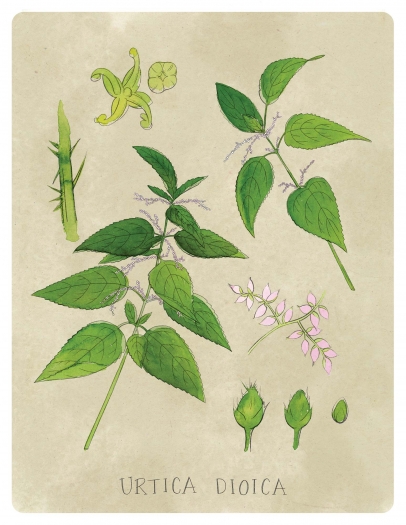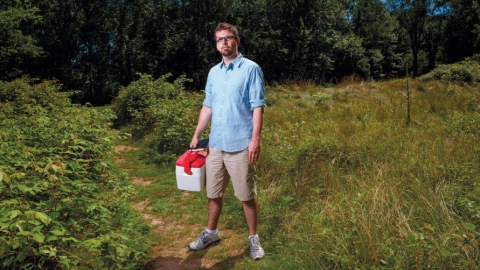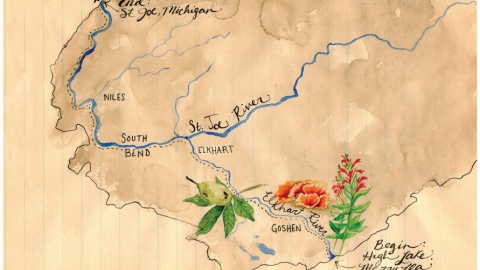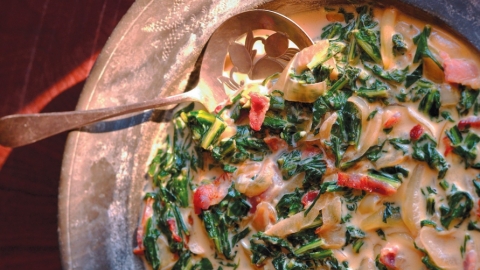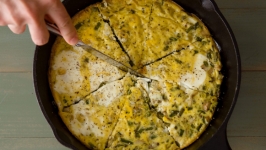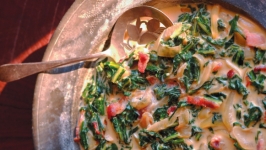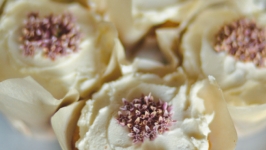Wild supergreen: foraging for stinging nettles
Out the high west window, the cottonwood’s glossy leaves quiver, passing around the fading light on this September evening. I pull on my boots and, though it’s warm outside, a medium-weight flannel shirt that used to be my grandpa’s. I toss an orange-handled pair of kitchen scissors and gardening gloves into a stainless mixing bowl, put a headlamp in my pocket, and walk out the back door onto the ridgeline path. On the way to the nettle patch, I check a couple of stumps for mushrooms. The ones I find aren’t edible—for humans, anyway—so I move along to the nearby patch of stinging nettles.
With garden gloves on, I begin cutting off new growth at the tops of the plants, gathering it in a bunch in my left hand as I cut with my right. I hear the sound of claws on bark as a raccoon climbs out of its den in a hollow red oak on the hillside. The animal doesn’t seem to notice me as I continue snipping. By the edge of the lake, a flock of wild turkeys flops around loudly on their roost. I look up every once in a while in response to sound or intuition. So many opossums cross the trail that I wonder if it is one animal walking in circles. I breathe more deeply as I’m there, covered head to toe and sweating profusely. It is well after dark before the bowl is full.
Michiana’s Edible Nettles
All nettles are edible after they are sautéed, blanched or cooked in soups. Two types grow abundantly around Michiana: wood nettles and stinging nettles. Wood nettles are a native variety that grows in clustered groups about waist high and has hand-sized, spade-shaped leaves that are finely toothed. Stinging nettles originated in Europe and traveled to North America with immigrants such as my ancestors from Germany and Ireland. Their leaves are shaped like spearheads with coarse teeth along the edges, and they grow to about chest height.
If you’re a beginning forager, nettles are a great place to start. If you’re not quite positive on your ID, rub the back of a leaf on your wrist and you will know for sure! Nettles have visible hairs, called trichomes, on their stems and the backs of their leaves to protect them from being eaten. If you have walked through a nettle patch wearing shorts, you know what happens when the trichomes break off and release their signature cocktail of histamines and other chemicals into your skin. For some, the reaction causes a mild burning and is short-lived, while for others it is excruciating and can last up to 48 hours.
Stinging nettles are one of the most nutritious greens on the planet; the healthiest varieties of cultivated greens pale in comparison. Dried stinging nettle leaves are used around the world as a tea for allergy prevention. Fresh stinging nettles are commonly applied to arthritic joints, because the body sends an anti-inflammatory in response to the histamines, formic acid and other chemicals.
As is the case with most foraged foods, it is important to pay attention to the season. The newly emerging nettles of spring are the finest eating, and the plants can be eaten until they begin flowering. Nettles are not edible as they flower and produce seeds, but the seeds are edible once they’re fully formed. After they have finished flowering and seeding, the tops of plants will continue to grow throughout the fall. The new growth of the fall is delicious. If you have a nettle patch, cut the plants back after they seed. Then it is simple to tell autumn’s new growth.
Bedtime Snack
Back in the house, I fill a large stockpot with water, add a teaspoon of salt (to keep the nettles green) and put it on the stovetop to boil. I pull the salad spinner out of the top cabinet, smudging the white door with my gloves. I find that I have to keep them on or I’ll absentmindedly grab the nettles at some point in the process. I wash the nettles twice and put a sauté pan next to the stockpot.
I slice a healthy chunk of Kerrygold butter into the sauté pan and add chopped Vidalia onion and minced garlic. After sweating the onions, I sprinkle pink mineral salt on the mixture and drop three handfuls of nettle leaves in the pan, softly turning them. They are finished in a couple minutes. My wife, Laura, and I talk about the nettles as we chew, noting particular flavors and textures. This nutritious food that grows itself on the land around our home seems to slow us down.
To finish up, I blanch the rest of the nettles for later use. I turn off the burner under the stockpot and dunk the rest of the nettle leaves in the water for 30 seconds, then pour them into a strainer and rinse with cold water. They last longer if the extra water is squeezed out, so I wrap them up in a towel and twist the moisture out into the sink. It is quiet in the house and our daughters are asleep. They will be excited to have nettles in their smoothies in the morning.


